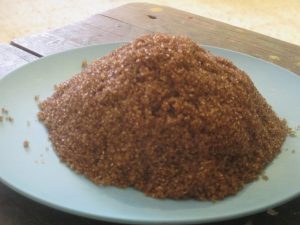The naturopath has generally two foes to deal with: Crystal, and her friend Glue. Sometimes one shows up in a patient, sometimes the other. We also have a bunch of tools to deal with each one of them, they’re all described in course Health Education #231. Feel free to register, it’s a bit over 600$. If you mention this article you get the registration fee for free! Let’s go back to our subject.
So how do you clean your body to get read of Crystals and Glues? And what are they, really?
Glues and Crystals Defined
Those two are signs of an intoxicated body. They show up when there’s an excess of something in your body. Let’s say… you ate too much protein-rich foods such as fish, meat, eggs or dairy. Could be. Why not? So an excess of those will cause the waste products (crystals in that case) to build up. They can also accumulate if you eat too much refined sugars and sweets – which is a more realistic case. Excessive acidic food is also a cause for cristal build-up and excess – but then again acidic food is the bottom line of almost any health issue. Everybody has an acidic terrain nowadays – the supermarket is full of acidic foods it’s very hard to not be a victim of acidity.
Glues come from a carbohydrate-rich diet of food grains, bread, pasta, as well as from excessive lipid consumption such as fats used for cooking. Long and poorly degraded starch molecule chains create glues. Mucus is generally the result of that.
How to Get Rid of Them?
Crystals prove to be more easily eliminated by drinking a lot of water, but the contrary is true for glues, which are more effectively eliminated by drinking less. Being non-soluble, glues tend to accumulate in lymph. By drinking less for a few days, the body is forced to find liquid in lymph in order to maintain a normal blood level. Thus, you’ll get rid of glues easier.
The therapy used to treat glue-related diseases consists in drying out the source of glue through an adequate dietary reform:
- Reduction or suppression of the incriminated foods
- Draining excess glue through the appropriate emunctory
- “Drying out” the organism as we mentioned just a little while ago.
For all crystal-related diseases, the basic therapy directly takes into account the characteristics of crystals.
- Correction of the diet, by reducing or temporarily suppressing crystal-producing foods
- Stimulation of elimination through the kidneys and sweat glands
- Abundant consumption of liquids, into which the crystals will dissolve and be eliminated
Glues and Cristals: Disease or Symptom?
All catarrhs are glue-related:
- respiratory catarrhs such as asthma, bronchitis, sinusitis, etc.;
- of the skin (such as seborrheic eczema, acne, etc.);
- also of the uterus and/or the digestive tract, etc.
Among crystal-related diseases are acute or chronic rheumatism, sciatica, stones, neuritis, and dry eczema.
So we’re talking about signs that give us the clue as to what the underlying problem is. Having a lot of mucus is not a disease per se, it’s a reaction from the body that serves as a signal: there’s too much of this or too much of that – get rid of it! Or buy a lot of tissue boxes.
Sugar: the Ultimate Foe
We like it so much though! The truth is, it’s not only bad for crystals, but also it causes glues. Indeed we learn from our courses, that sugars are part of a big family that have common and different characteristics.
 Mucus is usually the result of a diet that is too high in starch. Starch is made up of long chains of molecules that don’t break down properly and usually form mucus. Starches are always plant-based and include potatoes, wheat, cassava, quinoa, lentils, chickpeas, amaranth, Jerusalem artichoke, spelled, millet, barley, and rice.
Mucus is usually the result of a diet that is too high in starch. Starch is made up of long chains of molecules that don’t break down properly and usually form mucus. Starches are always plant-based and include potatoes, wheat, cassava, quinoa, lentils, chickpeas, amaranth, Jerusalem artichoke, spelled, millet, barley, and rice.
The crystals usually come from sucrose or regular or cubed table sugar. It is found in large quantities in candies, cakes, cookies, pastries, jams and some drinks.
You now have a better understanding of how sugars can lead to these two types of waste.
Conclusion: Find a Way Out for Them!
Whether it is “glue” or “crystal” waste, it takes an emunctory to eliminate it. Here are the main emunctories:
- for glues: liver, gall bladder, intestines and sebaceous glands.
- for crystals: liver, kidneys, bladder and sweat glands.
Secondary emunctories include: - for glues: the respiratory system and some say the uterine membrane.
- for crystals: membranes of the stomach, uterus, respiratory system.
If you enjoyed this article, maybe you’ll also like:




Leave a Reply